Kiyotake Kami Inoharu: Fourteen pit dwellings, the largest number nationwide for the Incipient Jōmon. The first arrow shaft straighteners in Kyushu are found.
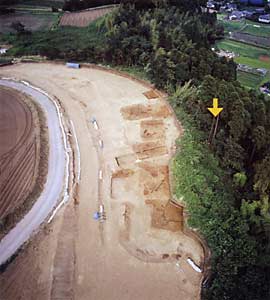
Panorama of the site (from the southwest) Located at 62 m elevation atop a tableland of volcanic soil on the north bank of the Kiyotake river, in the southwest portion of the Miyazaki plain. A spot in the vicinity with a bountiful flow of spring water has been verified (yellow arrow). A strong western wind blows in winter at this location, but the pit dwellings were discovered on a slope descending gently to the east, where the wind would be avoided.
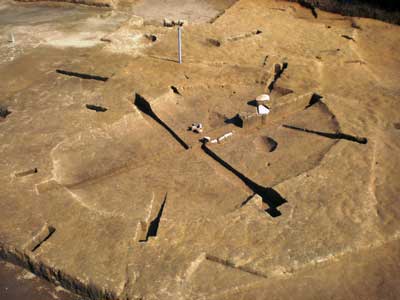
Dwelling No. 2 Postholes encircle the outer side of the cavity dug for the floor, and near the center is a hearth lined with a placement of stones. |

Distribution of archaeological features Adapted from Hakkutsu sareta Nihon rettō 2008 [Excavations in the Japanese Archipelago, 2008] (Bunkachō [Agency for Cultural Affairs], ed., Asahi Shimbunsha, 2008). |
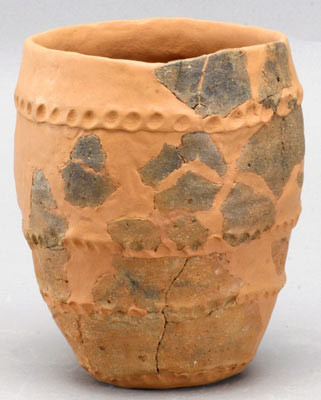
Shell impressed pottery Encircled with clay belts at four points between the rim and the base, onto which the hinged portion of a shell was impressed in a repeated pattern. This shell pattern is characteristically seen in pottery of the Incipient Jōmon of southern Kyushu. Rim diameter: 13.5 cm; height: 17.2 cm. |
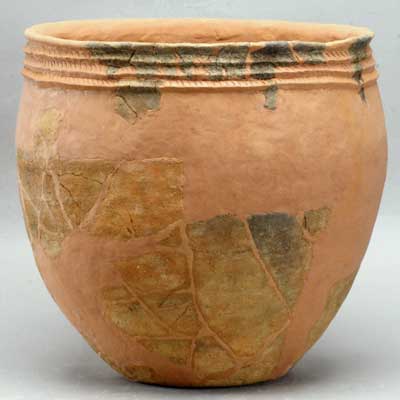
Raised band pattern pottery Incipient Jōmon, 12,000 BP. Rim diameter: 34.4 cm; height: 34.7 cm. Recovered together
with numerous bits of carbonized materials from near the center of
dwelling No. 8. The rim is encircled with three clay bands, on which
a pattern was incised with the fingernails to make a repetition of
the character |

Red painted pottery sherd Incipient Jōmon, 12,000 BP. Length: 5.4 cm; width: 5.2 cm. Crescent pattern pottery with nearly the entire surface painted in red pigment. In addition to this, pottery was found at the site with red pigment applied to the inner surface. |
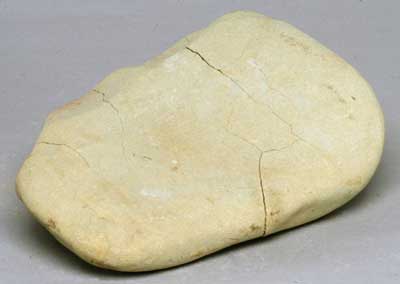
Stone mortar The weight is 9 kg. Used with a grindstone, it is thought to have been for grinding meal from nuts such as acorns. The surface used for grinding the nuts is slightly concave. Made of sandstone. Length: 32.2 cm; width: 24.5 cm. |
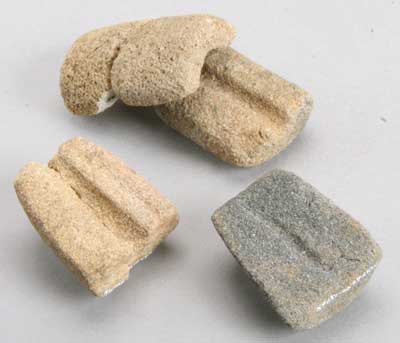
Arrow shaft straighteners Tools for straightening out the shaft of an arrow. Two pieces form a unit; an arrow shaft is inserted into the straight groove on the flat surfaces and is smoothed straight as it is drawn back and forth. There were eight pieces found at the site. All were made of sandstone, ranging 5.2 to 7.4 cm in length. Groove width ranges from 0.7 to 2.0 cm. |
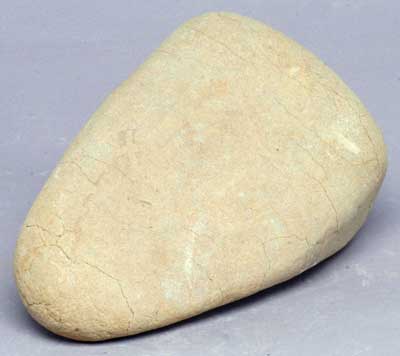
Anvil stone (whetstone) Incipient Jōmon, 12,000 BP. Length: 28.5 cm; width: 17.3 cm. On the periphery of the flat surface there are marks left by sharp blows. Weighs 8.5 kg, and is made of sandstone. |

Ground stone adze Incipient Jōmon, 12,000 BP. Length: 12.8 cm; width: 5.1 cm. A curved-back stone adze thought to have been used for making a dugout boat. The portion near the blade has been carefully polished. |

Hammer stones Incipient Jōmon, 12,000 BP. (Item at right) Length: 10.4 cm; width: 3.9 cm. Depressions have been left on the flat surfaces, and they are thought to have been used together with anvil stones or stone mortars as tools for splitting nut shells, etc. Round or slightly angular cobblestones of sandstone are used. The item at right is bright red because a burnt rock was used. |
Photos courtesy of Kiyotake municipal board of education.
Kiyotake Kami Inoharu Site, Kiyotake Town, Miyazaki Prefecture
Discovery: fourteen pit dwellings
Kiyotake Kami Inoharu is a settlement site of the Incipient Jōmon period (13,000-10,000 BP). In the FY 2007 investigation fourteen pit dwellings, the largest number nationwide for the Incipient Jōmon, were discovered along with stone arrangements and pits.
Based on the discovery of shell impressed and raised band pattern styles, both considered to be Incipient Jōmon pottery, the inclusion of Satsuma volcanic ash (from the Sakurajima eruption of approximately 11,000 BP) in the sediment of a portion of the pit dwellings, and on the radiocarbon dating result of approximately 11,700 BP for carbonized material discovered in the dwellings, the pit dwellings are understood to belong to the Incipient Jōmon period.
A small band repeatedly visited the location
As a portion of the pit dwellings crosscut adjacent structures, not all of them were lived in by the Jōmon people at the same time. Based on previous Incipient Jōmon examples in which only one or two dwellings are commonly found, and on the large amount of artifacts from the site, it is thought that a small band repeatedly visited this location. Further, as heavy items such as grindstones and stone mortars were recovered, long-term use of the settlement can be imagined.
Differential use of dwellings and weapon-making sites
Other noteworthy artifacts are arrow shaft straighteners, tools used in making the shaft for an arrow. This tool is found mainly in eastern Japan, and for some reason had not yet been discovered in Kyushu, which was thought to result from regional differences in lithic culture. But with this discovery it has become necessary to consider links and commonalities between Kyushu and eastern Japan.
The arrow shaft straighteners were all found to the south of the group of pit dwellings, and stone arrowheads, incomplete arrowheads and fragments were recovered from the vicinity. In other words the making of bows and arrows is seen to have been conducted at a spot slightly separated from the dwellings.
From the results of the current investigation we are thus able to glimpse how Jōmon man, who had begun living in pit dwellings, was using space differentially within a settlement. (Akinari Masahiro)
